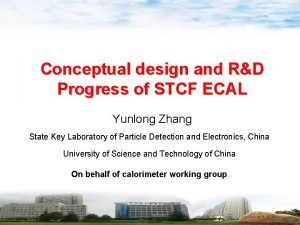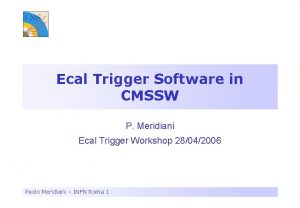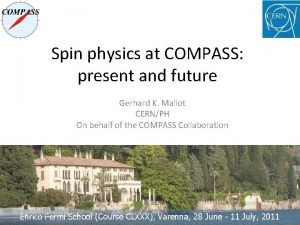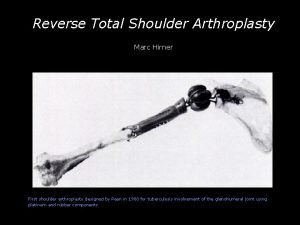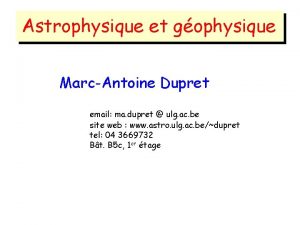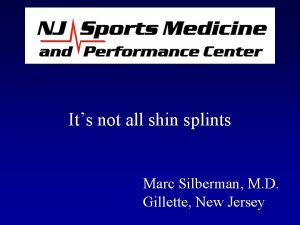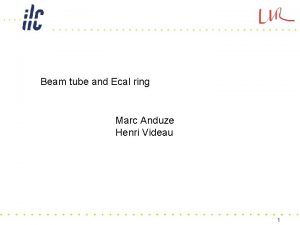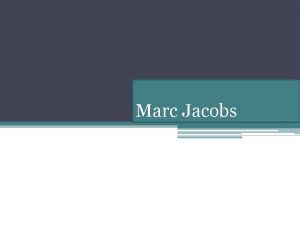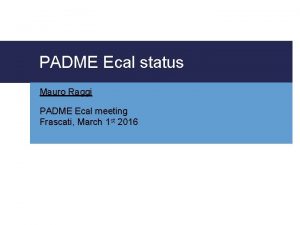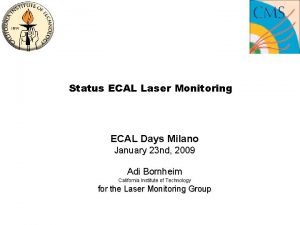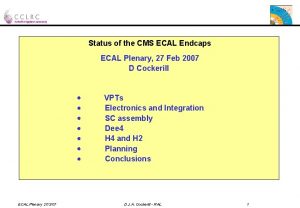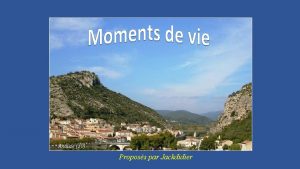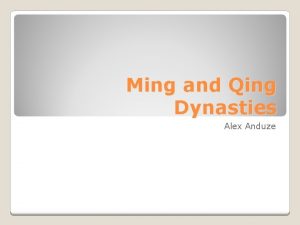Mechanical Status of ECAL Marc Anduze 301006 ECAL










- Slides: 10

Mechanical Status of ECAL Marc Anduze – 30/10/06

ECAL - Global presentation n n 17 94 n W/Si calorimeter (24 X 0 with 29 W layers) Weight full ECAL: ~ 112 T (80 barrel+32 End-Cap) Barrel : 40 identical trapezoidal modules End-Cap : constituted of 12 modules (3 types) ECAL module : alveolar structure - carbone fibers compound including half of W plates (fixed on HCAL End-Cap with rails) Minimization of dead zones Detection elements (detector slab) in each alveolar case (Si+W), FE chips integrated, pad size : 5× 5 mm 2 Multi-module End-Cap 180 Barrel module 00 16 840 Opening plan for full End-Cap Marc Anduze – 30/10/06 Détecteur SLAB

n Linear Analysis ECAL - Alveolar structure design Global simulations : global displacements Configuration 0° (Nodal displacements) and localization of high stress zone for different solutions (definition of dimensions) n Local simulations : more precise simulations and study of different local g parameters to design each part of theses structures Main ISSUES : Barrel module n Dead zones : thickness of main composite sheets Configuration 0° n Fastening system : choice of fasteners g g (metal inserts, rails…) n Thermal cooling (active or passive ? ) n Connectors ? End-Cap module Marc Anduze – 30/10/06 Configuration 90° g

ECAL/HCAL - Interface Fastening system ECAL/HCAL is fundamental for mechanical and thermal calculations (barrel and End-Caps): q choice of fasteners : rails directly inside composite or metal inserts ? q Connections set path in gap between ECAL and HCAL (via a panel for cabling interface ? ) q Rails are 1 way for positioning system (gravity support) ≤ 3 cm but a second complementary system may be added for fast interchange of modules… recommendation ? Only 3 cm q Whole End-Cap (ECAL+HCAL) assembly behavior available ? HCAL Barrel ECAL HCAL g ECAL/HCAL Configuration 0° Marc Anduze – 30/10/06 ECAL TSAI-HILL ECAL/HCAL Configuration 0°

ECAL - Thermal analysis q Thermal analysis for interaction on FE ships Thermal sources: 21. 8 M CALICE ECAL: ~ 82. 2 M of channels Assuming that the chip power is 25 µW/channel total power to dissipate will be : 2055 W external cooling OK inside each slab : necessity of cooling system but active or passive ? Ex: Pessimist simulation of heat conduction just by the heat shield : λ = 400 W/m/K (copper) ; S = 124*0, 4 mm 2 L = 1, 55 m ; = 50* chip = 0, 18 W We can estimate the temperature difference along the slab layer around 7°C and without contribution of all material from slab (PCB, tungsten, carbon fibers…) passive cooling OK ? Marc Anduze – 30/10/06

ECAL - Cooling technology External cooling location: for each module, on the front end, by pipes running in the space between ECAL and HCAL. Unfortunately, in the same space we will find all the slab‘s output/input. n example Cooling fans deported Heat pipes (Ø 2 mm) Slab’s front-end Nearly all heat generated by the chips will go to slab’s front-end. Then, some cooling option can be foreseen: n • Thermal conductors (heat shield) can be added in the slab to carry heat more efficiently along the slab direction. • Thermal cooling inside : by the way of heat pipes connected to cooling fans deported ; increase thickness of slab. Marc Anduze – 30/10/06

EUDET Demonstrator - Presentation Concept : to be the most representative of the final detector module : q A alveolar composite/tungsten structure with : - same radiator sampling : 20 layers with 2. 1 mm thick 9 layers with 4. 2 mm thick - 3 columns of cells to have representative cells in the middle of the structure (with thin composite sheets ) - Identical global dimensions (1. 5 m long) and shape (trapezoidal) - fastening system ECAL/HCAL (included in the design of composite structure) q 15 Detector slabs with FE chips integrated - 1 long and complete slab (L=1. 5 m) - 14 short slabs to obtain a complete tower of detection (typ. L=30 cm? ) and design of compact outlet. Marc Anduze – 30/10/06

EUDET - Detector slab (1) shielding: 100 µm (cooling ? ) Cables + packaging: 1000 µm PCB: 600 µm glue: 100 µm (ƒ pads size) wafer: 300 µm ground foil: 50 µm v. 1 Design SLAB Epoxy protection ? (cooling ? ) Heat shield: 100+400 µm (copper) Chip without packaging 6500 µm PCB: 800 µm Main ISSUES : Front End chips inside : Thermal dissipation (cooling ? ) Chip behaviour in an electron shower n Long structure : Design and fabrication problems (composite with segmentation of W plates, mechanical behaviour …) glue: 100 µm (needs tests) wafer: 300 µm ground foil: 100 µm Segmentation of PCB (design of an interconnection) n Diminution of the pads size Increases of the number of channels (thermal cooling ? ) v. 2 Design SLAB Marc Anduze – 30/10/06 Size of glue dots

EUDET - Detector slab (2) B d C ”P it un “ 7 CB P ” Chip « inside » Marc Anduze – 30/10/06 “en Connection between 2 PCB Exploded view

R&D – Techno. prototypes (2006 -2007) n Long Type H structures : q q n Design and fabrication of the long mould – (end of 2006) Fabrication of validation model (1 -3 samples ) module EUDET : - 1. 5 m long ; ≈ 500 Kg - real radiator sampling : 20 layers with 2. 1 mm thick 9 layers with 4. 2 mm thick q Design (mechanical and thermal simulations) of the module Optimization of composite sheets : studies of main parameters (thickness, shape. . . ) Fastening system on HCAL : design and destructive tests too Design and fabrication of the mould with an industrial expertise (DDL consultants) Transport tools q Fabrication of the structure (end 2007) q Mechanical support for beam test in 2008 q q Marc Anduze – 30/10/06
